
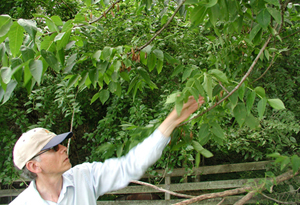
We would like to focus seed collections on states with infested counties and surrounding areas. Our initial focus will center on the five most widespread Fraxinus species in eastern North America:
Range maps of these are shown in our Maps area.
Ideally, the full ecogeographic ranges of these species will be sampled in a stratified fashion. In part, this can be accomplished by acquiring samples from as many Omernik Level III ecoregions as possible from throughout the native ranges. A copy of the Omernik Level III ecoregion map for North America can be obtained from:
ftp://ftp.epa.gov/wed/ecoregions/cec_na/NA_LEVEL_III.pdf. (Note: This takes some time to download)
In the future, we will also work to obtain representative samples of F. caroliniana (Carolina ash) in the southeastern US and of western ash species.
Fraxinus species are widespread throughout the eastern and central United States, with other North American taxa found in isolated parts of the southwestern and western United States. Trying to identify suitable native populations of Fraxinus that are worthy of collecting comes with experience and can initially be difficult. However, a few simple guidelines can be followed in order to ensure high-quality samples are collected:
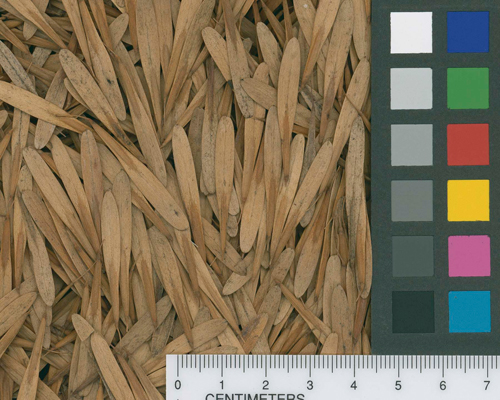
An initial summer reconnaissance to identify ash populations that meet the key points noted in "Guidelines for collecting seeds" is often extremely helpful. Summer visits are good times to locate the best areas of seed production, confirm site ownership and access, and make herbarium vouchers.
If you are planning to collect in (or you live in) an area that is within a Federal or State ash quarantine zone (see http://www.emeraldashborer.info/files/MultiState_EABpos.pdf for current map of quarantined and regulated zones), it is important that these quarantines not be violated. Ash seed samples and herbarium vouchers may be considered regulated articles and should not be transported out of quarantine zones without appropriate permits. A PPQ 540 or other permits may be required. Please contact your APHIS State Plant Health Director for more details. A contact list is available at http://www.aphis.usda.gov/services/report_pest_disease/report_pest_disease.shtml
After suitable populations with good seed production have been identified and "georeferenced" (with a GPS unit or fine-scale maps) during reconnaissance, seeds can be collected. Harvesting time generally occurs in the fall (depending on location timing will vary), though blue ash can mature its seeds earlier in the summer and some green ash populations can retain seeds well into winter. During late summer and autumn, seeds start to ripen by displaying a gradual change in coloration from green to yellow and then to tan or brown. The first seeds to fall from the trees are typically of poor condition.
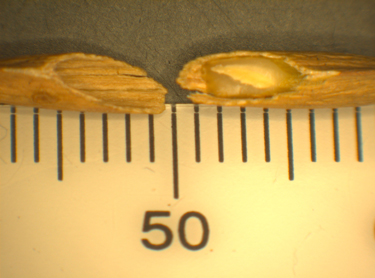

Initially, time should be taken to estimate seed quality for each parent tree. Carefully examine a small, representative sample of seeds by simply cutting them in half. Visual observations should reveal a whitish endosperm that completely fills the seed pericarp. A photograph of an empty/non-viable seed and a viable seed is displayed at right (top). Seed quality can also be reduced by ash seed weevils (Lignyodes sp. — right, bottom), which destroy the endosperm.
At each collection site, a minimum of 1,000 seeds should be collected from each mother tree, but a larger amount (3,000-5,000 sd) is recommended to increase the likelihood of long-term success. The table below lists the average 100-seed weights, average 3,000-seed weights, and the average volume (in liters; 1 liter = 1.06 quarts). The ranges of weights and volumes are fairly large (range of volumes shown in parentheses), so keep this in mind when estimating the actual weight or volume needed for your collections.
| Taxon | Avg 100-sd wts (gm) |
Avg 3000-sd wts (gm) |
Avg 3000 sd by volume (liters) |
| F. americana | 4.02 | 120 | 1-1/2 (7/8 to 2-1/4) |
| F. nigra | 5.39 | 160 | 2 (1-5/8 to 2-1/4) |
| F. pennsylvanica | 3.39 | 102 | 1-1/2 (1-1/4 to 2) |
| F. quadrangulata | 11.12 | 333 | 2-1/2 (2-3/8 to 2-5/8) |
The rough percentage of good seeds determined during collection by inspection will help you decide if collection is warranted or how much additional seed should be collected in order to reach the targeted quantity of live seed. Sample equally (relatively the same number of good seeds per mother tree) throughout the extent of the population. It is very important that seeds from each mother tree be kept separate.
If there are 5 to 15 (ideally 25) mother trees bearing a sufficient quantity of high-quality seeds within your collection site, then proceed to harvest seeds from each mother tree separately, either by hand from low branches or by cutting down seed-bearing branches. Pruning small branches (< 1/2 inch in diameter; i.e. < 12 mm dia.) with a pole saw can result in quickly obtaining a large amount of seed. Please note that seeds may disperse readily if a branch falls to the ground abruptly. Alternatively, depending on the seed-shattering characteristics of the parent tree, tarps can also be spread on the ground in order to catch seeds released from the tree by shaking the limbs or striking them with a pole. Large quantities of relatively clean seed can be gathered quickly in this manner. Do not collect seeds that have already fallen to the ground.
Fruiting trees may also be spotted more easily and from greater distances following leaf fall, but the ability to harvest large quantities of seeds at such a late stage can potentially decrease drastically. In addition, leaf samples may not be available for species identification during collection, but twig and seed characteristics along with bark patterns should facilitate identification.
The US Forest Service recently published a guide for ash seed collection with many useful hints to increase your overall success. See Methods for Collecting Ash Seeds to order a printed copy or download a PDF file.
Samples should be collected and stored in brown paper bags where they can dry upon collection. If seeds are wet, they should be air dried for at least 24 hours. Keep the seed collections in a cool (65-70 °F, 18-21 °C), dry (RH < 60%) place during the collection trip and prior to shipping. Do not freeze seeds. Do not allow collections to overheat, and do not leave them in a vehicle in full sun. Maintain ventilation around the collections at all times and try to park the collecting vehicle in the shade, or, at the very least, try to shade the windshield. Exposure to such sustained high temperatures can badly damage the seeds.
Clearly label all seed bags with a permanent black marker on the outside of the bag, along with a label containing the same information inside the bag. Seeds should be separated by mother tree and identified by marking each seed bag with an unambiguous numbering system, along with the proposed name of the species collected, the collection site name, and the collection date. If additional bags are needed to contain a large number of seeds taken from the same tree, simply indicate it is bag 1 of 2 or 3 of 4, etc. Seed bags should be folded and stapled.
Data collection forms should be completed for all seed collections. If an herbarium voucher was taken prior to collection, please include the voucher collection number that is associated with the sample being collected, along with associated information about any materials collected from these trees for DNA sampling.
When georeferencing ash populations, we prefer that you use a GPS unit and record your data in decimal degrees to at least 4 decimal places. Also, please set your unit to use the NAD83 datum. If you determined the coordinates retroactively, by using USGS topographic maps or online sources, please make sure that you note your source.
Ideally, a single point should be marked approximately in the middle of the population being sampled. If this is impossible because of access issues, please explain the relationship of the coordinates that you have recorded to the trees being sampled in "Other Notes" under the main heading of "Site Description" in the data entry form. It is not necessary to record coordinates for each individual tree, assuming that all trees are being collected from a single, contiguous stand. If a collection is being taken along a transect, trail, or road, you can include the coordinates of the starting and ending points in the "Other Notes" section.
In our primary target region, there are six, widely recognized native Fraxinus species. Here is a quick key to help distinguish among them during the growing season:
| 1. Young branches 4-angled, often winged | F. quadrangrandulata (Blue Ash) | |||||
| 1. Young branches more-or-less circular in cross-section | ||||||
| 2. Lateral leaflets without stalks | F. nigra (Black Ash) | |||||
| 2. Lateral leaflets with stalks | ||||||
| 3. Leaflets strongly whitened beneath | F. americana (White Ash) | |||||
| 3. Leaflets green or rusty beneath | ||||||
| 4. Lateral leaflets gradually narrowed at base into a narrow wing that runs down the upper part of the leaflet stalk | F. pennsylvanica (Green Ash) | |||||
| 4. Lateral leaflets acute at base; leaflet stalk without wings | ||||||
| 5. Leaflets with long, tapered tips; fruits very large (4 to 7.5 cm long) and narrowly oblong | F. profunda (Pumpkin Ash) | |||||
| 5. Leaflets with short acute or blunt tips; fruits smaller (2.5 to 5.5 cm long), widest above the middle, winged to the base | F. caroliniana (Carolina Ash) | |||||
Ash Key illustrations:

Other traits and habitat preferences that can help distinguish among these six species are described below. We have included some images of mature fruits (seeds), stems and buds that may be helpful for distinguishing among these species at other times of the year.





In addition, Fraxinus excelsior (European Ash) is sometimes cultivated as a landscape tree in the Eastern United States and Canada. It would key to F. nigra above. However, F. nigra has tufts of tan to reddish hairs at the base of each leaflet, but F. excelsior does not.
Initial reconnaissance efforts should occur in mid-summer in order to identify and document desirable, seed-producing ash populations. During reconnaissance, voucher specimens should be taken along with complete passport data. The purpose of voucher specimens is to document the populations from which seeds will be collected, as well as to verify that the species has been identified correctly. A minimum of two vouchers each of both vegetative and floral branches should be sampled per collection area and deposited in both national (U.S. National Arboretum Herbarium) and regional herbaria. If desirable, additional vouchers may be collected for the collecting team's own herbarium. The number of vouchers taken per collection should reflect the expertise of the collector, the degree of within-population phenotypic variation, and the possibility of two or more taxa occurring in the same location. A vegetative voucher specimen should comprise at least 12-14 inches long of annual growth, including at least two of the compound, pinnate leaves, both lateral and terminal buds. A "floral" voucher specimen should consist of a twig about 12-14 inches long, including at least two of the compound, pinnate leaves, both lateral and terminal buds, and one cluster of developing seeds. Having both vegetative and reproductive vouchers aids in identification, as morphological characteristics may be skewed due to the amount of annual growth that is sampled. Immediately after collection, the specimen should be pressed and labeled with the collection date, proposed taxonomic name, collection location name and/or description, and collection number. The collection number and date should be written in indelible ink on the outside of the newspaper holding the specimen. The pressed specimen should then be quickly dried at a moderate temperature to avoid molding and deterioration. Collection numbers should be assigned to each herbarium specimen following an unambiguous numbering procedure.
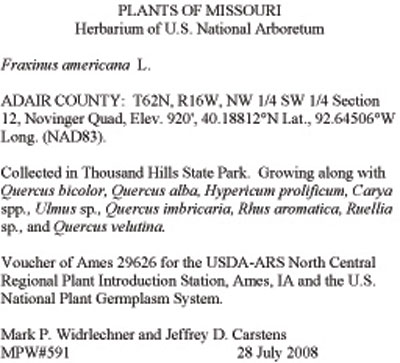
After specimens are dried, a computer-generated label for each specimen should be laser-printed onto archival bond paper and paper clipped to each specimen until it can be mounted by herbarium staff. An example of a voucher specimen label is shown at right. Please note, herbarium vouchers should not be mounted by collectors.
We recommend that digital images of the tree and surrounding habitat be captured. If images are captured, a consistent naming protocol should be followed so images can easily be linked to the corresponding voucher specimens. The collection number along with the collection location should be cited in the image file name or provided on the reverse side of the photograph.
During the collection of the herbarium specimen, collectors should complete data collection forms for each population vouchered, documenting the site location/description, latitude and longitude coordinates, habitat, associated vegetation, etc. This ensures that the seed lots will be properly documented in the NPGS's GRIN database. A completed data collection form is only necessary on a population basis and is not intended for each individual specimen.
Literature that further explains proper technique in sampling and handling herbarium specimens includes:
If you already have an unambiguous numbering system for your collections, we encourage you to continue with that. In our system, we include the initials of the collector, a four digit number to indicate the year collected, a three digit sequential number assigned to the population collected, and a three digit sequential number assigned to the specimen sampled within that population. Thus, if John A. Doe collects a voucher of Fraxinus from his tenth collection for 2008, the collection number for the third tree from that population would be coded as JAD/2008/010/003. The year (2008) is followed by the collection site (010) which is followed by the tree that was sampled (003).
| JAD / 2008 / 010 / 003 | ||
JAD |
= |
John A Doe |
2008 |
= |
collected in 2008 |
010 |
= |
10th collection site for year 2008 |
003 |
= |
3rd tree from the 10th collection site |
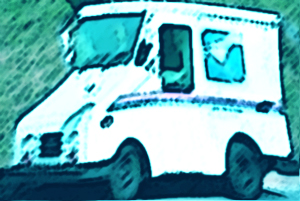
And if you have collected in (or you live in) an area within a Federal or State ash quarantine zone, your shipments of seeds and vouchers may require inspection and appropriate permits before shipment. Any permits that you received from APHIS or State regulatory officials must included within your shipment container. Please contact your APHIS State Plant Health Director for more details. A contact list is available at http://www.aphis.usda.gov/services/report_pest_disease/report_pest_disease.shtml
Seeds should be removed from their pedicels before shipment. Seed samples contained in brown paper bags should be clearly labeled on the outside with black permanent marker along with a label on the inside. Occasionally, large amounts of seeds are obtained during collection and require additional bags. In such cases, please indicate the number of bags for each mother tree (e.g. 1 of 2, etc.). Please ensure that all samples are secure as they may encounter rough handling en route. It is recommended to ship samples via ground transportation as conditions within an airplane may be unfavorable during transport on certain airlines. Some airlines consistently maintain safe temperature and air pressure in their cargo bays, while others do not guarantee safe conditions without prior arrangements. Samples should be securely folded and stapled shut. Shipment should include the collection data spreadsheet which is created using the form downloaded from the Forms page. In addition, please email the spreadsheet electronically to mark.widrlechner@ars.usda.gov. Notification of an incoming shipment is greatly appreciated. Please avoid shipping near holidays.
If you are shipping via private carrier service, please ship seed samples to:
USDA-ARS North Central Regional Plant Introduction StationIf you are shipping via the US Postal Service, please ship seed samples to:
USDA-ARS North Central Regional Plant Introduction StationWe can cover the cost of shipping seed samples and data collection forms to the NCRPIS only if FedEx is used as the carrier. A FedEx account number will be supplied by Mark P. Widrlechner upon request.
Once at the NCRPIS facility, collection data are entered into the NPGS's GRIN database, seed drying is completed, and the seeds are cleaned, their quality evaluated, digital images captured of both the seeds and collection forms. The seeds are then prepared for proper storage. Balanced, bulk samples from each collection area will be assembled at the NCRPIS and back-up samples transferred to the National Center for Genetic Resources Preservation (NCGRP) in Fort Collins, CO for long-term conservation. After balanced bulks are created, the remaining seeds from individual mother trees will be kept as separate seed lots.
Once voucher labels have been created and attached to the dried specimens, they can immediately be shipped to the proper locations which would include the U.S. National Arboretum Herbarium and an active regional herbarium.
The U.S. National Arboretum Herbarium primary contact and mailining address:
| Robert Webster | U.S. National Arboretum Herbarium |
| Email: robert.d.webster@ars.usda.gov | Attn: Robert Webster |
| Phone: 202-245-4542 | 3501 New York Avenue NE |
| Washington, D.C. 20705-2350 |
The cost of shipping herbarium specimens to the National Arboretum Herbarium can be covered only if FedEx is used as the carrier. A FedEx account number will be supplied by Robert Webster upon request.
Appropriate regional herbaria can be determined by contacting:
| Alan T. Whittemore | |
| Email: alan.whittemore@ars.usda.gov | |
| Phone: 202-245-4550 | |
If available, additional herbarium specimens can be given to the collecting team's local herbarium, otherwise duplicate specimen(s) can also be sent to either the national or regional herbarium.
Due to the fragile nature of voucher specimens, they should be packed with special care to avoid damage during shipment. Specimens should be protected by intercalating them between sheets of corrugated cardboard, and then bundled and the cardboards securely tied. The bundles should be wrapped in paper which is then taped. The bundles should be packed in a strong box, sized only slightly larger than the bundles to reduce shifting in transit. Any extra space in the box should be filled with packing peanuts, bubble wrap or similar materials. When shipping herbarium voucher specimens, please include a paper copy of the data collection form for each specimen along with a list of all the specimens being shipped. For each specimen, the corresponding label and data collection form should be paper clipped to its corresponding sheets of newsprint. An electronic version of the packing list should also be transmitted by email to:
Robert Webster (robert.d.webster@ars.usda.gov),
Alan T. Whittemore (alan.whittemore@ars.usda.gov), and
Mark Widrlechner (mark.widrlechner@ars.usda.gov).
Notification of an incoming shipment is recommended. Avoid shipping near holidays.